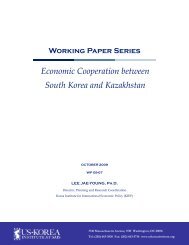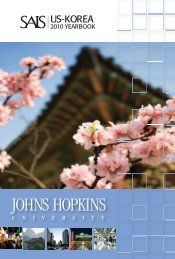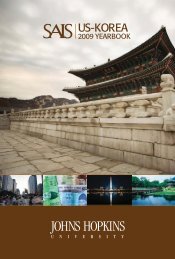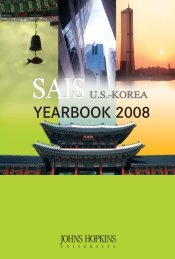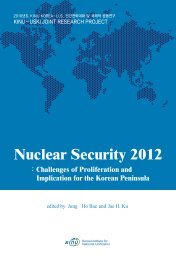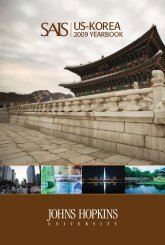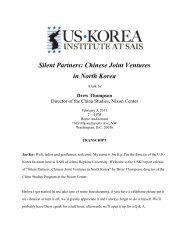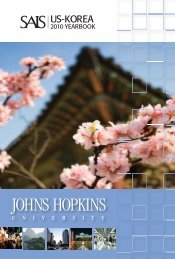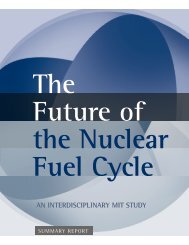Kaesong Industrial Complex - US-Korea Institute at SAIS
Kaesong Industrial Complex - US-Korea Institute at SAIS
Kaesong Industrial Complex - US-Korea Institute at SAIS
You also want an ePaper? Increase the reach of your titles
YUMPU automatically turns print PDFs into web optimized ePapers that Google loves.
<strong>SAIS</strong> U.S.-<strong>Korea</strong> Yearbook 2009This paper assesses the legitimacy and effectiveness of the KIC in terms ofthe economic liberal theory th<strong>at</strong> peace can be cre<strong>at</strong>ed through trade. By testingthe main hypothesis th<strong>at</strong> both the DPRK and the ROK remain committed toeconomic cooper<strong>at</strong>ion projects due to common vested interests, the paper alsoseeks to answer why the DPRK government continued to keep the KIC doorsopen despite the political risks and dangers <strong>at</strong>tached to liberaliz<strong>at</strong>ion. The paperwill first explore the history and objectives of the KIC in order to better assessthe current situ<strong>at</strong>ion. Thereafter, the paper will analyze the effectiveness of theKIC project in improving inter-<strong>Korea</strong>n rel<strong>at</strong>ions by assessing two aspects: (1)economic incentives versus political pressure and (2) social and human changeswithin the KIC.II. HISTORY AND OBJECTIVE OF THE KAESONG IND<strong>US</strong>TRIALCOMPLEXThe idea of economic cooper<strong>at</strong>ion between the two <strong>Korea</strong>s origin<strong>at</strong>ed in 1984during the South <strong>Korea</strong>n Chun Doo-hwan administr<strong>at</strong>ion. Chun pioneered aseries of ambitious dialogues with North <strong>Korea</strong> until the talks came to a haltafter the U.S.-ROK joint military training exercise. Convers<strong>at</strong>ions restartedin the 1990s during the Inter-<strong>Korea</strong>n Basic Agreement talks. The succeedingKim Young-sam administr<strong>at</strong>ion continued to engage the DPRK economicallyuntil the two <strong>Korea</strong>s hit a nuclear stalem<strong>at</strong>e. Since then, a clear and radicalvision for the ROK-DPRK economic engagement plan was officially launchedduring the Kim Dae-jung administr<strong>at</strong>ion with the commencement of his“Sunshine Policy.” During this era, Kim Dae-jung and the newly establishedNorth <strong>Korea</strong>n leader Kim Jong-il agreed upon cre<strong>at</strong>ing an ambitious economicproject in <strong>Kaesong</strong> along with other groundbreaking trade exchanges. TheRoh Moo-hyun administr<strong>at</strong>ion followed the footsteps of his predecessor withhis “Peace and Prosperity” policy by engaging the North and providing aid.Currently, the Lee Myung-bak administr<strong>at</strong>ion takes a hard-liner stance towardsthe DPRK, diverting away from the ten years of friendly economic policiestowards North <strong>Korea</strong> under the past two liberal administr<strong>at</strong>ions. Yet Lee, underhis “pragm<strong>at</strong>ic approach,” still remains committed to the KIC and economicengagement with the North. In October 2009, the ROK Ministry of Str<strong>at</strong>egyand Finance announced th<strong>at</strong> South <strong>Korea</strong> is planning to raise its 2010 budgetspending on inter-<strong>Korea</strong>n economic cooper<strong>at</strong>ion by 30 percent from 2009. TheLee administr<strong>at</strong>ion has planned for budget spending amounting to 398.2 billionwon (approxim<strong>at</strong>ely $339.6 million) for 2010 in order to support economiccooper<strong>at</strong>ion projects within the DPRK, up from 304.6 billion won in 2009.184



